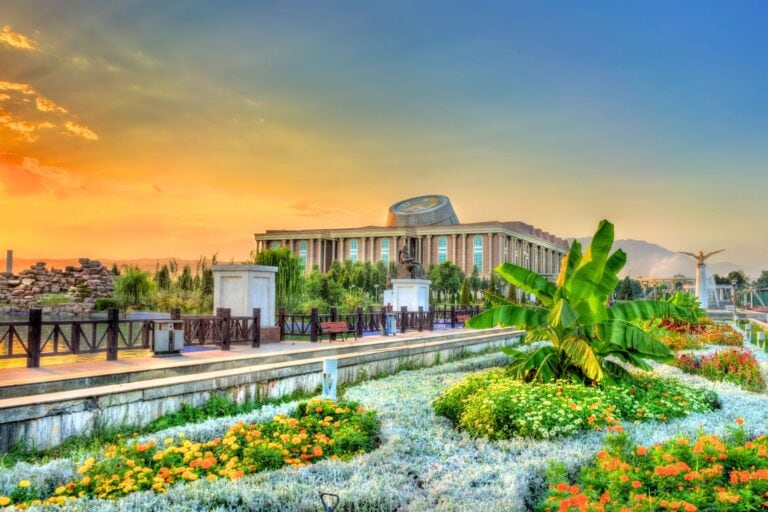
Go World Travel is reader-supported and may earn a commission from purchases made through links in this piece.
When I found out that I’d be moving to Tajikistan for work, I immediately lumped it together as “one of the Stans”. I quickly learned, though, that out of the five Central Asian countries, Tajikistan has its own unique charm and blend of culture from its long, fascinating history. Since the country is 93% mountainous, there are also spectacular hikes, lakes, and views throughout the country.
I’ve been living in the capital of Tajikistan, Dushanbe, for nearly a year now and have embraced every perk of this rapidly developing city. Since it’s in a valley surrounded by mountains, not only is there temperate weather here, but also many affordable—or completely free—things to do and several ways to see and experience the intriguing mix of Persian traditions, Soviet architecture, and Muslim influence.
I am regularly still in awe of the bright lights illuminating the monuments and parks around town, the kindness of the people, and the manifested nuances of a multi-faceted background. I’ve had guests who didn’t know what to expect from their trip here, and it’s been rewarding to see their astonishment at all the city has to offer.
A Local’s Top 10 Things to Do in Dushanbe
Here are my top 10 things to do for a first-time visitor in Dushanbe, Tajikistan.
1. The Istiqlol Monument in Dushanbe
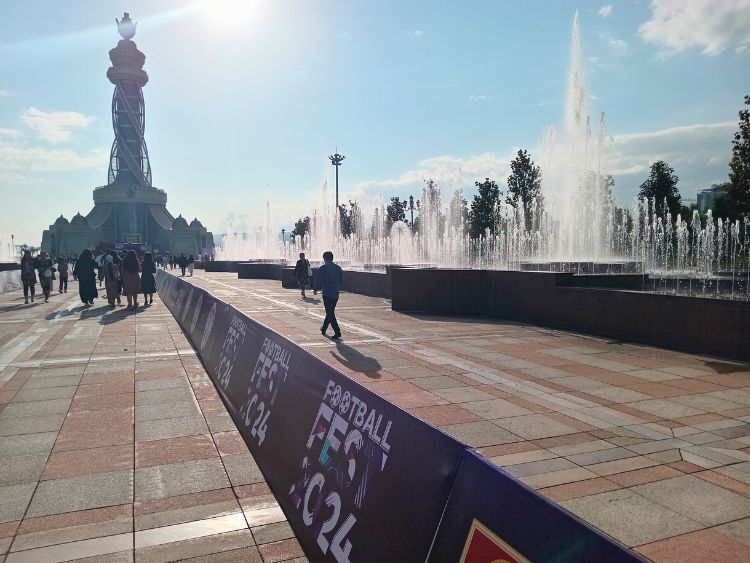
Undisputedly, the most famous landmark in Dushanbe is the Istiqlol Monument, sometimes called the Independence and Freedom Tower. Recently constructed and completed in 2022, the tower stands 121 meters tall with an enormous crown capping the top off. It’s said to be a gift from the Chinese commemorating 31 years of friendship with Tajikistan and honoring the 30th anniversary (in 2021) of Tajikistan’s independence from the Soviet Union in 1991.
The building has a museum on the first two floors featuring historical books, traditional outfits, classical instruments, and paintings by Tajik artists. For 40 ($3.75 USD) somoni, you can visit the museum open every day of the week except Mondays, and for 70 ($6.50 USD) somoni, you can also head up to the observation deck on the 14th floor.
Best Tips & Tools to Plan Your Trip
There is a 360-degree view over the city, from the Varzob River running through the capital to the cement factory just to the north and downtown in the south. It’s the best way to get oriented with the major sights in town, and I never get tired of the view.
In the evenings, the water fountains surrounding the tower and at the arched gateway to the plaza light up and flash different colors. Many events throughout the year, especially during the summer, are also held here, with televised concerts and sports festivities featuring the sparkling tower in the background.
Some of the largest national holiday celebrations, such as Nawruz, the Persian New Year, are also staged in the square. Since Tajikistan was a part of the First Persian Empire, this also leads to it being more closely aligned with Iran and Afghanistan, linguistically and culturally, than the other four Central Asian countries. Nawruz is held on the Spring Solstice of March 21st each year,
2. Somoni Monument and Rudaki Park
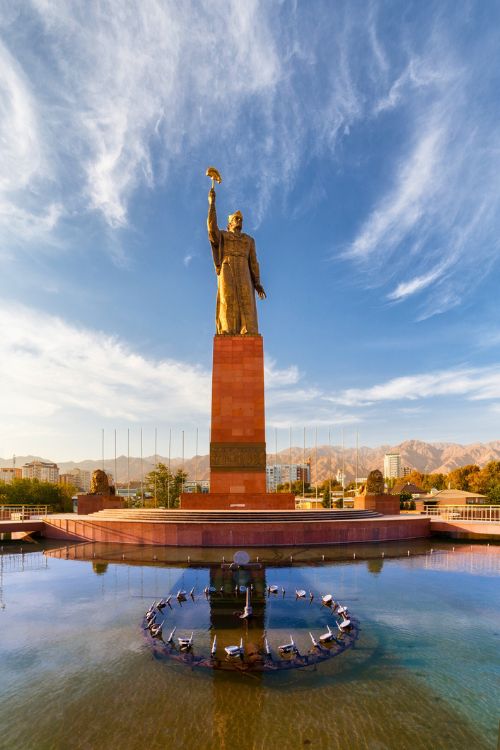
In the center of downtown is Friendship Plaza, surrounded by the National Library and government buildings at this intersection. Ironically, rising from the center, perched on a short flight of steps, is a monument dedicated to Ismoil Somoni, the nation’s hero and a significant emir (ruler) of the Persian Empire. The modern currency of Tajikistan, the somoni, is also named after him.
The bronze statue is 25 meters high and complete with a 43-meter-high golden arch behind him, topped with a golden crown. Two lions sit regally on either side of the statue. Night or day, rain or shine, local and international visitors take photos here, and you can always count on a photographer trying to sell you a photo they indiscreetly took of you for 2 somoni ($0.20 USD).
Across the street to the north is Rudaki Park, named after a famous Tajik poet. It has long and beautiful green stretches with various varieties of flowers in the spring through the fall. Bird-shaped street lamps are illuminated at nighttime with a water fountain in the center around a statue of Rudaki himself and an arched mosaic that was delicately hand-crafted.
The President’s office (also known as “the Palace of the Nation” or “the Tajik White House”) is to the west and visible through iron-wrought gates, although, like all government buildings in Tajikistan, close-up photos aren’t permitted.
3. Flagpole Park
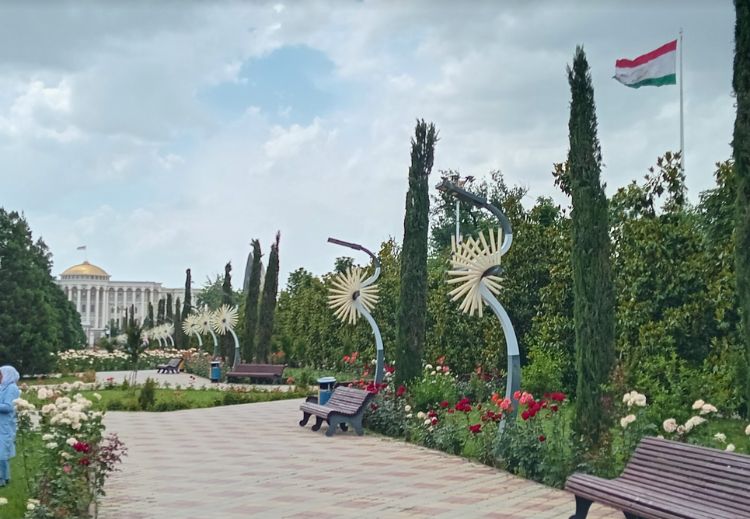
Walking distance from Rudaki Park and the President’s office is Flagpole Park. Home to the previous record holder for the highest flagpole in the world (165 meters tall), the park is a relaxing place to walk around at all times of the year, with an artificial lake next to cute cafes, bridges, water fountains, and statues of historic Tajik figures dotting the pathways.
Outdoor exercise equipment lines the far side of the lake, and you can smell the rose garden from a distance. Inflatable play spaces for children and ice cream stands are popular in the summer, and quotes from Tajik President Emomali Rahmon are posted all around the lampposts, citing the importance of nature and family time.
Also in the park is the National Museum, a four-story building that covers natural history, the flora and fauna of the region, fine arts, and religious history. Stuffed wild animals, interactive hallways you can walk through with looming armies in the distance, and large stones carved with verses from the Quran are some of the highlights for me. It costs 35 somoni ($3.25 USD) for a foreign adult or 40 somoni ($3.75 USD) if you want an English-speaking tour guide.
4. Dushanbe‘s Victory Park
Victory Park is the place to go for those who like a view. On the northeast edge of the center, head up the road by the brewery—— and through the main gate to Victory Park, dedicated to soldiers from World War II. If you turn right onto the first small, uphill path, you’ll find Zafar, an expensive but nice restaurant with indoor and outdoor seating to take in the view.
Many other dirt trails split off from the main driving path that taxis can come in on, and young groups of friends, families and romantic couples often branch off to find some privacy and enjoy the numerous round gazebos at different viewpoints.
Horse riding is popular in the warmer seasons to explore the hills off the dirt paths. At the center of the park, on a sloped path with several flights of stairs featuring faces and names of the soldiers, is a long banner and monument with an eternal flame that pays tribute to the fallen.
On May 9, the country celebrates Victory Day, the day in 1945 when the Soviet Union defeated Nazi Germany. The President and several top government and military leaders attend the procession, which is closed off to the public.
The Victory Day colors of orange and black can be seen throughout the country during the first half of the month. To the side of the monument is a real IS-2 tank from WWII and two commemorative columns, recently relocated from their previous location on an island dividing a multi-lane street in the south of the city center.
The columns have reliefs carved into all four sides of each one, depicting aspects of the Germans’ surrender and proud Soviet soldiers in action.
5. Rohat Tea House
On the main street of Rudaki Avenue, which crosses the city center running north to south, is the Rohat Tea House. Easily recognizable from its white pillars and tall, hand-painted ceilings, the two-story tea house is reminiscent of traditional Tajik tea houses and one of the oldest still standing today.
It’s now a full restaurant with a wide range of traditional Tajik dishes, such as plov (osh), an oily rice dish with meat, mantu (Tajik dumplings), and lagman. This noodle soup dish is popular all around Central Asia, and the Rohat Tea House, as any good Tajik restaurant should, makes their own chewy, hand-pulled noodles.
Samsas, triangular oven-baked savory or sweet pastries, are also delicious; available fillings depend on the season. My favorite is the pumpkin (kadu), which is very popular in the fall and winter. If you want a change of pace from tea or soda, try the compote. This typical Soviet-era drink is made from boiled fruit water and has just the right amount of sweetness to refresh you on a hot day.
6. Kahki Nawruz Dushanbe Tea House
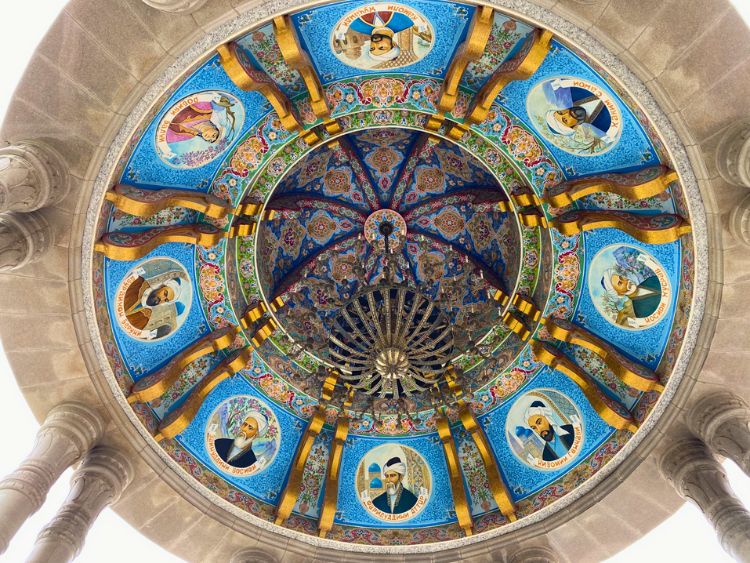
Completed in 2015, the Kahki Nawruz Tea House is the largest in Central Asia. Besides a tea house and restaurant, it has four enormous halls where the President hosts official delegations from foreign ministries and visiting organizations.
You must book a tour to see the four halls, which aren’t open to the public. The tour costs 50 somoni ($4.60 USD) a person and lasts approximately 25 minutes. The halls are almost overwhelming in detail and intricacy. One has a 3-ton chandelier, and another is decorated with 29 semi-precious Tajik stones.
The guide speaks Russian, Tajik, English, and Mandarin, as she tested out on my parents and I when we visited last month. The guide seemed to have just as much fun switching back and forth between the languages as we did deciphering what she was saying.
You can also roam the exterior of the tea house for free. The tall pillars with patterned high ceilings and gazebos in the back overlooking the lake are asking to be in a selfie. There is also a movie theater on the top floor, a bowling alley, a pool hall, and a go-karting course in the basement!
7. Mehrgon Bazaar in Dushanbe
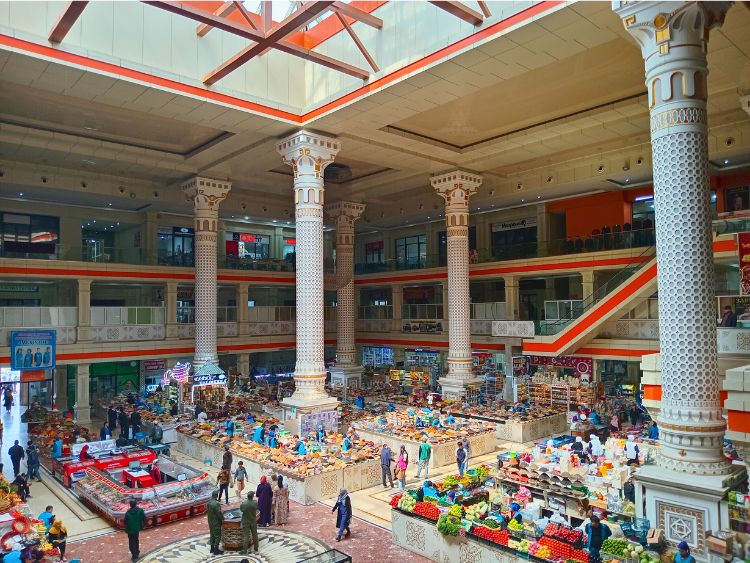
The Mehrgon Bazaar, the traditional marketplace in town, is worth checking out to see the old ways in which produce and goods were sold. The main building is a large open space with huge pillars and a massive skylight letting sunlight stream in. It’s the most photogenic room, and you can take the escalators to the second floor, which is mainly empty, besides a few electronics stalls, to get a good overview.
Like many other Central Asian markets, the goods are sold open-air, on tables piled high with a merchant ready to negotiate and haggle for each grain and stalk. The products are located together by type; the rice and beans are on the right, and the fresh vegetables and fruit are on the left. The newly-made sausages and cow feet are in the back, and pickled vegetables are by the exit to the back.
The back sections of the market use small lights sparingly placed on the low ceiling, leading to a darker, more mysterious ambiance. A must-try here is the kurut, a classic Central Asian snack handmade from strained milk and preserved with salt. They’re typically shaped in small, hard balls and sold by the kilo, although you can buy one just to try for 2 somoni ($0.20 USD). Beware that it can be quite strong for a foreigner not used to the extremely sour and salty taste!
The side sections hawk household goods, from hand brooms and kettles to wooden stamps with nails that leave a design in the center of their kulcha, the traditional round Tajik bread. They are completely outdoors, with only a plastic tarp to protect the vendors’ socks, plastic toys, and traditional hats. There aren’t public buses or taxis to reach the bazaar, as it is farther off the main road, but it’s accessible by foot or by marshrutka (white minivans). It’s open every day until dark.
8. The Tajik Academic Opera and Ballet Theater
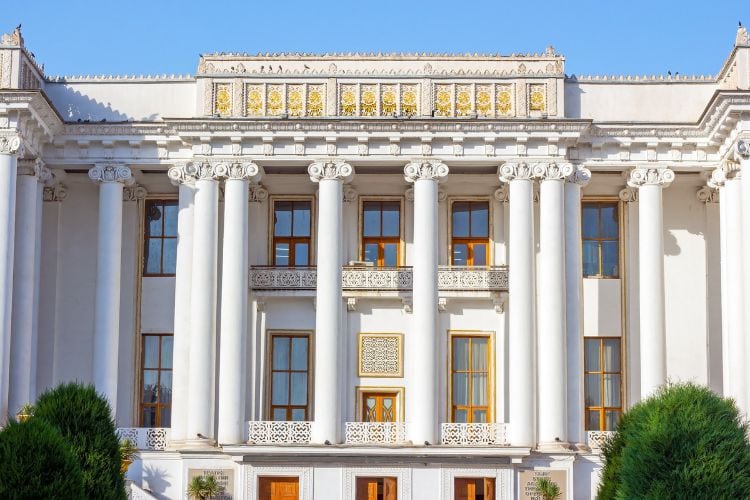
One of the only remaining preserved buildings in town is the Opera and Ballet Theater in the center of town. It is named after Sadriddin Ayni, a famous Tajik poet and literary figure. The exterior is easily recognizable, particularly at night when the tall, white columns are well-lit, accented by the small park’s fountains.
Beyond the cashier’s entrance, a grand, carpeted staircase leads up to the main entrance, and artwork and costumes of former productions are displayed in glass cases. A cafe is on the second floor for breaks and intermissions, and balconies provide a spectacular view of the stage and orchestra.
The range of shows that are held at this theater is impressive. They have musicals, such as The Hunchback of Notre Dame, to operas, like Carmen, and movie soundtrack-inspired evenings or classical symphony orchestra nights.
The schedule and online purchases are available on echipta.tj, though the website will charge an extra 10% online service fee. Tickets typically range from 30 somoni to 80 somoni ($2.80-7.50 USD). You can also buy tickets in person at the ticket counter of the theater but note that the ticket office’s working hours can vary.
9. Traditional Dance Shows

There are a number of Western-style pubs and bars that you can frequent…or you can visit the one-of-a-kind traditional dance shows infused with modern twists at one of a handful of restaurants that offer live performances every evening. The two most popular are Bukhoro and Anzur, located diagonally from one another on Druzhba Narodov Street, near the Dushanbe Mall.
Both restaurants offer a complete menu, including Western and Tajik food, shisha, dessert, and seating arranged perfectly around the dance floor. The shows start at 7:00 pm nightly and include musical performances by solo singers, groups of musicians, traditional dancers and karnai (Tajik longhorn) performances. Between the blaring music, dazzling outfits and coordinated colorful lights, it’s a true attack of the senses you won’t want to miss.
10. Hissor Fortress

The number one day trip from Dushanbe is to the Hissor fortress, located 29 km away. Popularly believed to originally belong to the 5th century Bukhara empire, which spanned all five Central Asian countries, the fort has been reconstructed several times over due to the number of armies, empires, and conquerors that have passed through the region throughout the centuries.
The oldest part is the arched gate, dating back 2,500 years, and you can still see the distinct layers of reconstruction from the oldest stone on the bottom to the top layer of new bricks.
At the top of a long flight of newly-built stairs running along the front of the fortress walls, a renovated structure shows what the emirs’ home would have looked like, with a view over the entire Hissor Valley. Each ruler received 24 wives, chosen by their well-positioned families, and 100 concubines, chosen for their physical beauty.
Sweeping Views from the Top
From the top, you have a full view of the amphitheater where the soldiers would entertain themselves, the well, which was the primary water source, and the old tea house and gazebos where the men could relax.
Next to them was the flat open field for horse riding and riders practicing for buzkashi. A traditional sport in Tajikistan and across several neighboring countries, this sport involves men (no women are allowed) on horseback fighting to grab a goat carcass, sometimes weighing upwards of 50 kg, and throw it into a hole or across a line.
They’re typically held in March and are free to watch. A buzkashi game I attended once was so crowded with people squatting along the edges of a massive dirt field that it was hard to catch what was happening. However, the excitement was palpable.
Announcers periodically called out updates, but I was too distracted to pay attention with all the aromatic sunflower seeds being roasted behind me, horse riding equipment sellers shouting around the parking lot, and stray horses trotting and neighing just behind the rowdy spectators.
Hissor Fortress Cost and What You Get
The fort costs 10 somoni ($0.90 USD) per foreigner to enter, and across the way is a madrassa (a religious school), which has been converted into a museum, and costs another 10 somoni to enter. Each dormitory, which used to fit three students to one room, has been reconfigured to depict traditional scenes from ancient Tajik lives.
One room showcases the wooden hand-carved book stands for the Quran, and the mat is where a student would diligently study it. A miniature wooden model of cows yoked together sits on the ground and an old-fashioned boot made from cowhide is on display.
A third shows a mannequin of man and wife on their wedding night, in full head-to-toe regalia, surrounded by an elaborately decorated newlywed bedroom. On my first visit, the guide laughed while describing this room as the “end of freedom”. According to him, the couple would stay for 40 nights together.
During that honeymoon period, they were not permitted to separate from one another. There was also a tradition where both the bride and groom would stare into a mirror until they were given a command, and the first person to step on the other’s foot would be the dominant person in their marriage!
How to Get There
To reach the fort by public transportation, take Bus #8 from the center to the Zarnisor taxi station on Ismoil Somoni Avenue. It costs 10 somonis per person in a shared taxi, which will depart when the car has 4 passengers, to reach Hissor town center. For the private taxi, it costs another 15 somoni ($1.40 USD) – you’ll have many drivers yelling at you for your clientele at the terminal taxi station- to go to the fort, which is less than 10 minutes from the center. It takes approximately one hour in total.
Bonus: The National Teahouse

Fun sighting: On the way there (and back), you’ll pass by a tea house with a gigantic watermelon on top – yes, you read that correctly! Inaugurated in 2015, it is officially called the National Teahouse and honors this popular fruit, an important crop in the region.
The tea house is 141 feet tall and has a capacity of over 2,000. The most popular question I get asked is if there are any watermelon-flavored tea drinks or watermelon-themed decor inside. While the answer is ‘no,’ it’s still fun to snap a shot in front of. After all, it’s consistently included in articles listing the most bizarre structures in the world!
If You Go to Dushanbe:
In Dushanbe, all taxis are well-marked and use a meter, which gives a fixed rate. However, taxi apps do exist if you prefer. You’ll need a SIM card to confirm your account. “Yak” and “Rakhsht” are the most popular taxi apps.
If you buy your SIM card at the airport, register it at the airport. It’s much easier than registering it in town.
Plenty of ATMs and banks are in the center of town, but be aware that Visa cards are far more accepted than Mastercard. Most places, apart from top hotels and Western restaurants, are cash-only. Other currencies aren’t accepted.
If you plan to stay longer than 10 days, you must register with the Ministry of Internal Affairs (OVIR) within the first 3 days.
Download Google Translate – offline, for good measure- for Russian and Tajik. The Tajik language was added recently and translations are imperfect, so don’t count on just that.
Read More:
Author Bio: Annie Elle is originally from Los Angeles, though she currently lives in Dushanbe, Tajikistan. She has lived overseas since 2011, working in various aspects of international education. Annie enjoys playing volleyball and exploring new foods and art forms in her free time.
- Exploring the Culture and History in Fascinating Astana, Kazakhstan - July 24, 2024
- Breakers & Beyond: Top 10 Things To Do in Newport, Rhode Island - July 23, 2024
- Laid-Back Lombok: Coconut, Coffee and Coral Reefs - July 22, 2024

